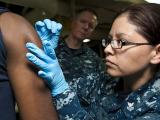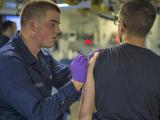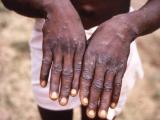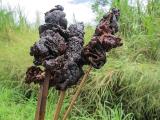May 4, 2007 (CIDRAP News) – A woman from Alaska experienced vulvar vaccinia after she was intimate with a US military member who had received his smallpox vaccination 3 days before, according to a report from the US Centers for Disease Control and Prevention (CDC).
The report, published in today's issue of Morbidity and Mortality Weekly Report (MMWR), said the woman sought treatment at a public health clinic in Alaska in October 2006 for increasingly painful vaginal tears that she said were not caused by sexual abuse or trauma.
Vaccinia, a rare cutaneous and sometimes systemic reaction to smallpox vaccination that can occur in vaccinees or in close contacts of vaccinees, has been reported more frequently in the medical literature since the US military revived its long-discontinued smallpox vaccination program in late 2002. By June 2006 about 1.1 million US service members bound for the Middle East and other areas thought to be high-risk had been vaccinated.
In March a 2-year-old Indiana boy was hospitalized with severe eczema vaccinatum that he contracted from his father, a soldier who had recently received a smallpox shot.
In the woman's case, in early October 2006 clinicians swabbed one of her two vulvar lesions and diagnosed secondary candidiasis; however, her symptoms continued to worsen despite treatment with over-the-counter medication, the MMWR report said. A healthcare provider then diagnosed cellulitis, discontinued the over-the-counter remedy, and prescribed a 7-day course of oral cephalexin. The patient's symptoms resolved 1 week later.
In the meanwhile, the Alaska State Virology Laboratory (ASVL) found the woman did not have herpes simplex virus, but it was unable to identify what virus she had. About a month later, the virus remained unidentified after the ASVL submitted it to a reference lab.
On Jan 9, 2007, the ASVL submitted the unidentified isolate to the CDC, where cloning and sequencing of her sample, based on products from specialized polymerase chain reaction (PCR) testing, identified DNA bands that matched vaccinia virus sequences. Additional PCR testing performed by the CDC Poxvirus Laboratory revealed that the woman's isolate was consistent with a vaccine-strain vaccinia virus, and the lab relayed the results to the ASVL on Jan 30.
Upon receiving the woman's test result, Alaska state health officials interviewed the woman and learned that she had never been vaccinated against smallpox but that the only sex partner she had had from 1 month before her infection until the lesions were healed was a US service member. She said their intimate contact involved manual stimulation and vaginal intercourse, and she didn't remember seeing bandages or unusual skin lesions on her partner.
When state health officials interviewed medical officers at the military base, they found that the soldier had been deployed overseas in late October. He had received a smallpox vaccination on Sep 19, 2006, along with instruction on vaccination site care and proper hand hygiene. They found no other transmission of the virus from either the soldier or from the woman to other people, including the heathcare workers who examined her.
The US military revived its long-discontinued smallpox vaccination program in late 2002, and by June 2006 about 1.1 million service members had been vaccinated.
Contact vaccinia, as in the woman's case, is more common than the more severe eczema vaccinatum or progressive vaccinia. According to the US Department of Defense (DoD) Web site, 61 cases (36 lab-confirmed) of contact vaccinia occurred, mainly to spouses and adult intimate contacts, between Dec 13, 2002, and Apr 12, 2007. The MMWR report said lab-confirmed vulvar vaccinia after sexual contact with vaccinated military members has also been reported in New York and Texas since the DoD resumed its smallpox vaccination program.
The CDC and the DoD have received four reports of nongenital contact vaccinia since Mar 8, 2007, related to recently vaccinated service members, the MMWR report said.
In an editorial note that accompanied the report of the woman's case, the CDC wrote that to prevent contact vaccinia transfers, healthcare providers should educate vaccinees on proper handwashing after bandage changesas well as on how to avoid other contact with the vaccination site. It said asking patients who seek treatment for vesicular lesions that resemble vaccinia about contact with recent smallpox vaccines can speed diagnosis and provide quicker contact tracing, clinical intervention, and counseling about preventing further transmission.
CDC. Vulvar vaccinia infection after sexual contact with a military smallpox vaccine—Alaska, 2006. MMWR 2007 May 4;56(17):417-19 [Full text]
See also:
DoD smallpox vaccination information
http://www.smallpox.army.mil/event/SPSafetySum.asp
CIDRAP overview of smallpox, including information on risks of vaccination

















